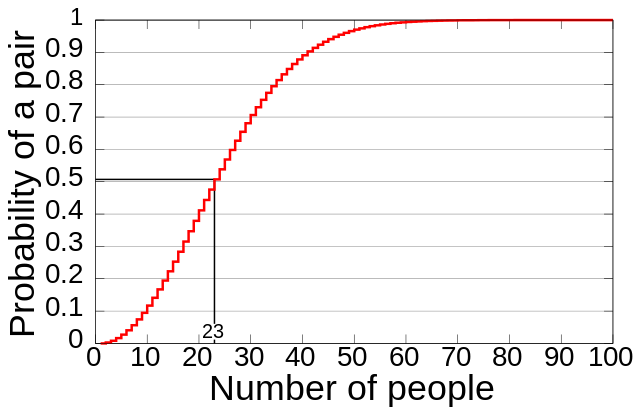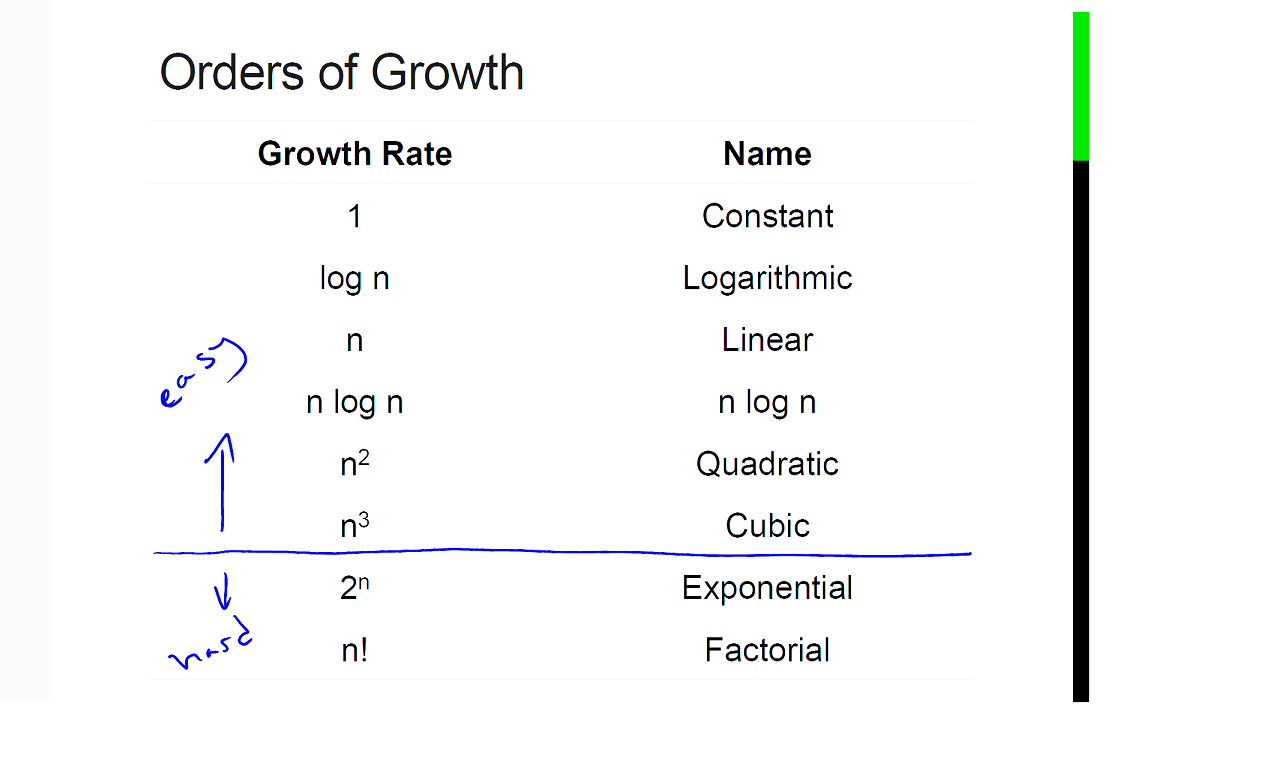CS350
Lecture Notes - 1
Happy Birthday!

Are there two people in this room with the same birthday?
- If so: what day is it?
How might we go about answering this question?
- One possible algorithm:
for each person in the room:
find each's birthday on the calendar
if the calendar day is marked
return that day
else
mark that day
return false
- Another possible algorithm
for each person in the room:
write each's birthday on the whiteboard
for other people in the room:
if other's birthday is on the whiteboard
return birthday
return false
Which of these algorithms is better?
- What does it mean for an algorithm to be better?
- How much effort does each one take?
Are there other algorithms that solve this problem?
Complexity:
- How do we compare algorithms?
- Efficiency
- Time
- Space
- Simplicity
- How to measure?
- Generality
- How to measure?
- Efficiency
- How do we compare problems?
- What are the limits of computation?
Efficient procedures for solving large scale problems
- Today, one trillion is a large problem
- In my college days, one million was a large problem
- In your other PSU prof's days, one thousand was a large problem (few decades ago)
Scalability
- Track how our algorithms perform as inputs get larger and larger
Why study algorithms?
- It's required
- Recognize common patterns and problem-solving strategies
- Be able to analyze algorithms for efficiency
- Not be constrained by programming language
- Better hardware is not a solution
- Strengthen mathematical, programming, and problem-solving skills
- Build a repertoire of algorithmic building blocks
- It's fun
- Companies that are hiring care about algorithms
Administrative Details
On Syllabus:
David Lu
Office: TBA (Feng Liu's old office 120-09)
email: dlu@pdx.edu
Course webpage: https://davidjlu.github.io/CS350/
Will use D2L as a grade book, so you can access and keep track of your grades through the quarter.
TA: Neil Babson
Office Hours: Tues/Thurs 2-3PM in fishbowl
email: nbabson@pdx.edu
Go over syllabus
Look at schedule.
Schedule is tentative.
Winter weather policy!
Schedule Philosophy and Textbook
Textbook is grouped by design strategy
-
Pros
- Focus on design strategies
- Return to same problems multiple times over the course of the quarter
-
Cons
- Return to same problems multiple times over the course of the quarter
- Unnatural in real world
Group by problem type - CLRS (Algorithms Bible)
-
Pros
- Focus on analysis -- immediate comparison between algorithms
- Natural in the real world
-
Cons
- Students may not be able to keep up with design strategies
Levitin is supposed to be much more readable than CLRS
Schedule and Assessments:
Homeworks
* 4 problem sets
* 2 will feature implementing some algorithms and testing
Midterm
Final - Date?
Intro to Algorithms
"An algorithm is a sequence of unambiguous instructions for solving a problem, i.e. for obtaining a required output for any legitimate input in a finite amount of time." (Levitin 1.1)
Another Example
Find Duplicates
Input: a length n array, A, of integers.
Output: true if the array contains a duplicate and false otherwise
for i <- 1 ... n
for j <- 1 ... n
if i !=j and A[i] = A[j] then
return true
return false
How do we know whether this algorithm correctly solves the problem for any legitimate input?
Asymptotic Analysis
- Running time usually varies with input size
- How do we measure input size?
- Comparisons between algorithms should be independent of hardware and programming language
Idea: Count basic operations -- the operation contributing most to the running time
Analysis - Find Duplicates
(why 2?)
Units for measuring running time
Let be the execution time of an algorithm's basic operation, and let be the number of times this operation needs to be executed for the algorithm. Then we can estimate the running time of a program implementing this algorithm by the formula
Less Stupid Find Duplicates
Input: a length n array, A, of integers.
Output: true if the array contains a duplicate and false otherwise
for i <- 1...n-1
for j <- i+1...n
if A[i] = A[j] then
return true
Is this a correct algorithm to solve the problem?
Analysis - Less Stupid Find Duplicates
What happens if we double the input size?
About 4 times longer!
Orders of growth

Also factorial
Exponential and above is HARD!

For Wed read sections 2.1 and 2.2.
I will prepare HW1 and place it in the assignments tab on the course website.